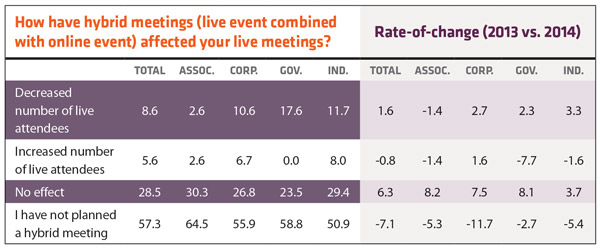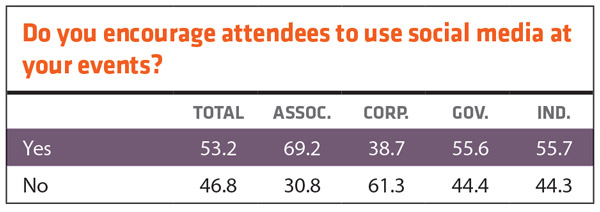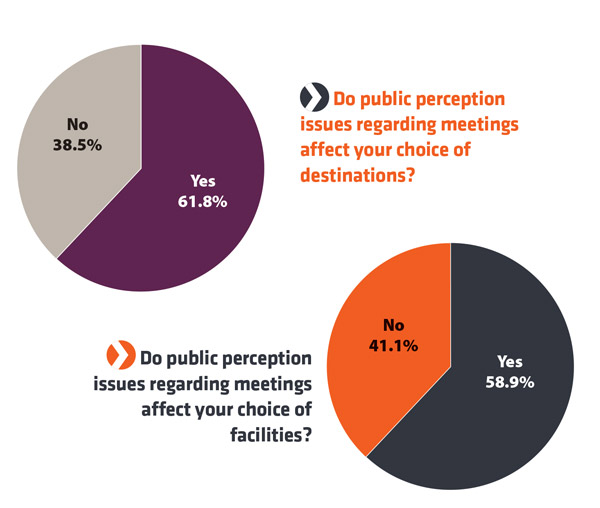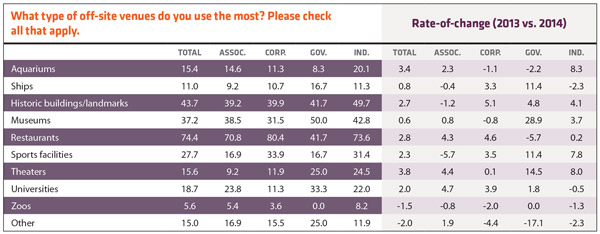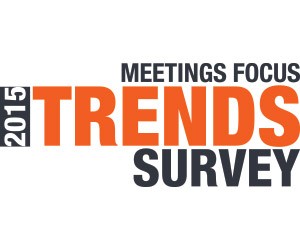Will a rising tide lift all boats? That seems to be the biggest question when examining meetings and hospitality industry predictions and the results from this year’s Meetings Focus Trends Survey. While many facilities are gearing up for a great year, will demand and meeting planner budgets keep pace?
"If you look at it from the 10,000-foot view, the view in the U.S. is more positive than we've seen in a long time, from an occupancy and demand perspective," says Bobby Bowers, senior vice president of Smith Travel Research (STR), which tracks U.S. hotel trends. "Rate growth is good, and supply growth will not be that huge in 2015."
Of course, STR specializes in tracking hotel metrics for a clientele made up of hotel owners, so what could be good on the supplier side of the equation could be problematic on the planner side, especially if budgets remain flat.
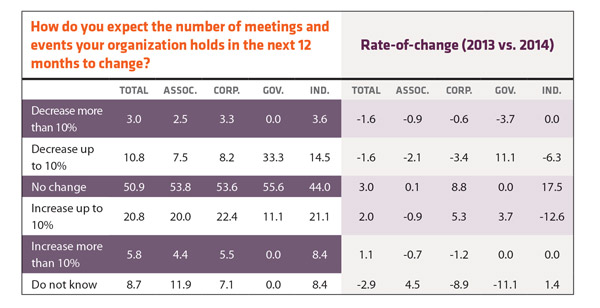
Overall, STR is predicting RevPAR (revenue per available room, a key indicator of hotel financial health) to increase between 5 percent and 7 percent in 2015.
"The way things are right now, it's really good, from a hotel operations perspective," Bowers says. "All the signs that you want to see are just real, real good, and demand has actually been accelerating."
The positive hotel industry forecast comes on the heels of a 2014 that saw a strong increase in demand, so although 2015 may not show a large year-to-year increase due to a robust 2014, indicators point to continuing growth.
"That would include meetings and conventions," Bowers says, in regard to the meetings segment picking up steam. "That's really been weighted down for a long time and wasn't coming back, but now toward the latter part of '13 and through '14 meetings have come back strong."
Planners may take solace in a couple factors, however. STR believes most of the rate growth will occur in the transient segment, and because meeting planners book much further out, favorable rates may already be locked in.
"From the planner's side, because the demand is good and performance is good, it could be tougher negotiation-wise, but many times those things are negotiated a year or two, or more than that, out. I think that hotel revenue management people like to have the security of having a good percentage of their house sold, so they tend to take a fairer approach as to what rates will be."
As far as the hottest U.S. hotel markets, Bowers singles out a few that have performed exceptionally well in the last year.
"The markets that have been really strong are the ones you can imagine: San Francisco, Miami, New York. New York has been good, but that's one of the markets where we've seen a whole lot of new room supply, but they're still running occupancies in the 80s.
"Nashville has been really, really good," Bowers continues, "but I think that as you move into 2015 it would be hard to imagine Nashville's performance being sustained all the way through 2015."
Star RevPAR performers have indeed included Nashville, with an almost 19 percent increase; Atlanta (nearly 14%) and Denver (over 16% growth). Washington, D.C., had a tough 2014 in terms of RevPAR, respectively, registering growth of only about 4 percent.
Although the destination RevPAR leaders will certainly have a hard time matching their success in 2015, the outlook is still weighted to the supplier side, so Bowers stresses that meeting planners should move with haste begin negotiations in order to lock in rates. And on the flip side, of course, secondary and tertiary markets that haven't seen this recent spate of success will cede some negotiation leverage to planners during the next year.
THE SURVEY RESULTS
Tech and Green/CSR
This year’s Meetings Focus Trends Survey attracted complete responses from nearly 550 meeting planners.
New questions in this edition centered around meetings technology, most notably Internet bandwidth, and social media strategy.
When asked how important Internet bandwidth was to their choice of a facility, 15.3 percent of respondents stressed that it was critically important and 34.4 percent indicated it was very important. Less than 10 percent said it was not important at all.
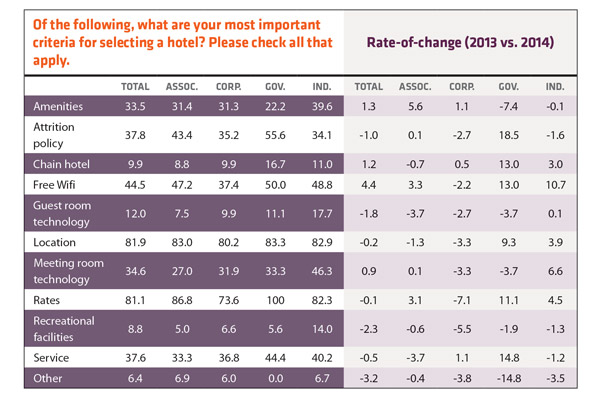
The importance of technology and Internet bandwidth was further evidenced when survey takers were asked how planning had changed for them in the 12 months prior, with the most popular response—expressed by nearly 35 percent—being they were more concerned with tech capabilities and bandwidth.
Free Wi-Fi (44.5%) and good meeting room technology (34.6%) both made strong showings in the question asking planners to select the most important criteria for choosing a hotel, but of even more importance were location (81.9%) and rates (81.1%). Attrition policy was pegged as the most important factor for 37.8 percent of respondents.
When asked what their biggest challenge will be in the next year, however, learning and utilizing new technology only registered with 8.4 percent of the respondents, with 43.1 percent indicating that increasing costs would be their biggest stressor in the next 12 months; 26.4 percent of association planners named declining attendance as their biggest potential hurdle in 2015.
In another tech-related question, a solid majority of planners still haven't hopped on the hybrid—or virtual—bandwagon, with more than three quarters saying they've planned neither. For those that have, however, almost 30 percent say it hasn't affected attendance at their face-to-face meetings. The outlier here was government planners, of which nearly 18 percent said hybrid meetings have resulted in a decrease in face-to-face attendees.
Perhaps a bit on the disconcerting side, at least for those high-minded folk who place a premium on sustainability and corporate social responsibility (CSR), 67 percent of respondents said they did not expect to plan a green/sustainable meeting in 2015, and nearly three quarters indicated that they wouldn't offer a CSR element in their meetings.
The integration of social media into meetings, however, made a respectable showing, with a little more than 60 percent of respondents (and nearly 77 percent of association planners) indicating they used social media outlets to promote their events. More than half of all of the planners said they encourage attendees to post accounts of their meetings via social media, with the lion's share, 69.2 percent, being association planners.
Corporate planners were a little cooler to the idea of soliciting attendee social media participation, with only 38.7 percent responding that they encouraged tweeting, Facebooking and the like.
Career Issues
Meeting planners remain a generally happy bunch, with more than 80 percent either somewhat (34.2%) or extremely (48%) satisfied in their choice of career. As with last year's survey, government planners were slightly less content, with 36.8 percent being extremely satisfied, which was down 15 percent from last year's survey. It seems most of those who aren't absolutely jumping for joy put themselves in the "somewhat satisfied" column (42.1%), which increased 19.9 percent from the previous survey, conducted in the fall of 2013.
PageBreak
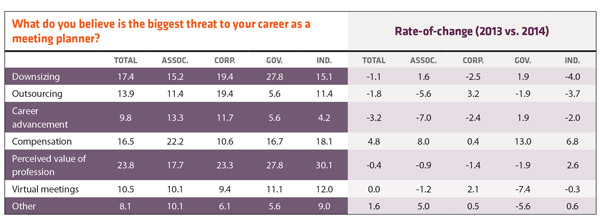
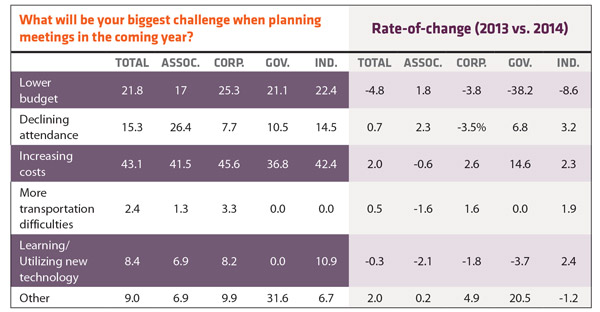
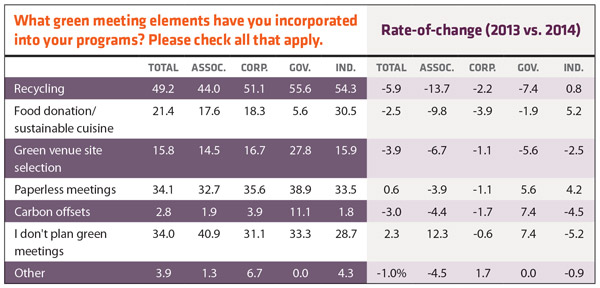
Although planners were generally satisfied by their choice of career, it seems they aren't convinced that others value the job they do, as 24.3 percent noted that the "perceived value of their profession" was the biggest threat to their career. This was followed by downsizing (17.4%), compensation (16.5%) and outsourcing (13.9%) as the biggest career-killers. Only 10.5 percent listed virtual meetings as the biggest threat to their livelihood.
When it comes to organizations supporting their careers, 64 percent said they attend educational events, 41.9 percent are members of industry associations such as PCMA and MPI, and 29.1 percent noted their organizations support obtaining industry accreditations such as a CMP or CMM designation.
Association planners received the most support, and registered a healthy increase in the year-to-year numbers relating to CMP/CMM certification (+7.3%) and industry association memberships (+6.1%).
A little more than 20 percent of planners said they receive no training at all.
Budget/Costs
According to MPI's most-recent Meetings Outlook Report, planners can expect overall budget growth of 1.7 percent next year, with costs increasing 5 percent for air travel and 4 percent for F&B and catering.
Results from the Meetings Focus Trends Survey found that more than half of meeting planners expect their budgets to remain flat in 2015, with about an equal number on each side predicting their budgets will either increase (14.8%) or decrease (15.4%) by 10 percent.
A sizable majority (43.1%) identified increasing costs as what they expect to be their biggest challenge in the coming year, with 2.6 percent more corporate planners selecting that option in this year's survey when compared to the previous year.
In tandem with worries about increasing costs, 21.8 percent of planners said having a lower budget to work with will be their biggest challenge in 2015.
Oddly enough, government planners were the segment that least thought lower budgets would their chief concern during the next year, at 21.1 percent, a decrease of 38.2 percent from the previous year. Of course, this probably points to government planners having their budgets cut to the bone in the last few years, so perhaps they've bottomed out?
In a related result, the number of meeting planners who identified the economy as the biggest threat to the meetings industry came in at a sizable 37.8 percent, but although the nation's sluggish economy topped the threat-level list, the number of planners who selected it actually dropped more than 14 percent this year, with 23.5 percent less association planners identifying it as the most vexing issue on the horizon.
Attendance/Number of Meetings
The possibility of declining attendance was noted as the chief concern over the next year for 15.3 percent of respondents, with 26.4 percent of association planners singling it out as their biggest worry over the next 12 months, besting the other segments by at least 10 percentage points, and 18.7 percent more than their corporate counterparts.
Attendance remained stable in the 12 months before the survey, with 56.1 percent indicating it had stayed flat.
Survey-takers said they expect the number of meetings they will hold next year will increase, however, with 20.8 percent believing they will hold up to 10 percent more meetings (20% of association planners; 22.4% of corporates; 11.1% of government; and 21.1% of independents). On the flip side, 10.8 of total respondents believe the number of meetings they will hold next year will decrease by 10.8 percent.
When asked how the planning of their meetings had changed in the previous year, 17.7 percent of planners said they held fewer meetings, led by government planners (38.9%) and followed by independents (21.3%), corporate (19.7%) and association (10.1%).
The trend line is pointing down slightly, however, as the number of those indicating they held fewer meetings in the past year was down single digits across the board from the previous year's survey, with the exception of independent planners, of which a nominal 1.4 percent more said they held fewer meetings in the past year.
Duration of Meetings/Planning Cycles
The average duration of a meeting held fairly steady this year, with 19.4 percent of planners responding that their typical meeting lasted three days; 15.6 percent selected 2.5 days and 15 percent chose 2 days.
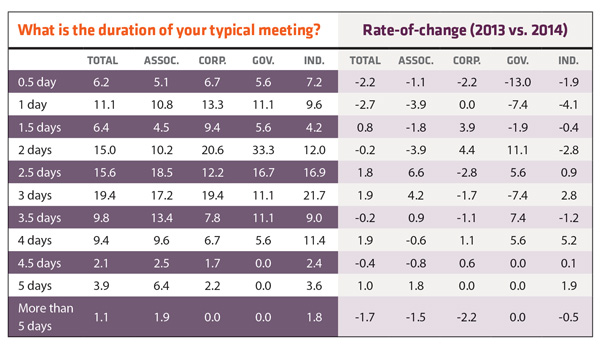
Of note is the rate of increase in the number of association planners trimming their programs back, with 6.6 percent more noting their typical program is 2.5 days in this year's survey; 4.2 percent more selected three days this year, however.
The largest rate-of-change for the duration question was from government planners, with 11.1 percent more indicating two days as their average length of meeting this year; 7.4 percent less selected three days.
In perhaps a small reversal of the long-term trend toward shorter planning cycles, 36.4 percent responded that they plan their meetings seven to 12 months in advance, which was up 4.2 percent from the previous year; 5.2 percent more association planners selected this time frame in this year's survey. When asked whether they expect their planning cycles to be longer or shorter during the next 12 months, however, 16.7 percent believe it will be shorter and 11.4 percent predict it will be longer, but the overwhelming majority, 71.9 percent, expect no change in the amount of time it takes to plan their meetings.
The Big Picture
In total, it looks like suppliers can expect continuing good fortune in 2015, and meeting planners may need to brace themselves for potentially higher costs and relatively flat budgets, but a slight projected increase in the volume of meetings may signify that proverbial rising tide that will lift all boats.
The 2015 Meetings Focus Trends Survey is a proprietary Meetings Focus online study that was distributed to 31,745, Meetings Focus subscribers. As an incentive to complete the survey, respondents were offered a chance to win one of five $50 Visa gift cards. Conducted in October 2014, the survey generated 542 complete responses.
Want to discover the latest meetings industry trends on attrition, technology, planning cycles, attendance, activities and budgeting? Check out even more charts from our annual Meetings Focus Trends Survey by clicking here!
